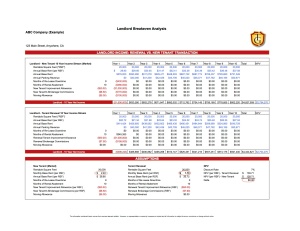 It is amazing to me how many times I have represented tenants who would prefer to remain in their current location only to find that their landlord wants to “hold them hostage.” What do I mean by this? Well, most landlords are pretty smart and they understand how expensive it is for a tenant to relocate. Between the tenant improvements, moving costs, furniture and technology costs that accompany a relocation, a huge amount of the tenants working capital can be spent on a relocation. Many landlords will use this knowledge to leverage a higher effective rent from their “captive tenants.”
It is amazing to me how many times I have represented tenants who would prefer to remain in their current location only to find that their landlord wants to “hold them hostage.” What do I mean by this? Well, most landlords are pretty smart and they understand how expensive it is for a tenant to relocate. Between the tenant improvements, moving costs, furniture and technology costs that accompany a relocation, a huge amount of the tenants working capital can be spent on a relocation. Many landlords will use this knowledge to leverage a higher effective rent from their “captive tenants.”
“Educate the Landlord”
 So, how does a tenant escape this trap, other than leveraging their occupancy in the marketplace and threatening to relocate? The answer is to educate the landlord. This can be done with an “Indifference Analysis” showing the landlord that he or she may have a downside worse than the tenant’s.
So, how does a tenant escape this trap, other than leveraging their occupancy in the marketplace and threatening to relocate? The answer is to educate the landlord. This can be done with an “Indifference Analysis” showing the landlord that he or she may have a downside worse than the tenant’s.
 Such an analysis compares the landlord’s net present value of cash flows from two scenarios: 1) retaining the tenant; and 2) losing the tenant and releasing the space to another company. This analysis makes clear to the landlord that it also has huge costs associated with the tenant moving out of the building. Tenant improvement allowances, free rent and significant periods of downtime will eat a landlord’s cash flow. Even using the rosiest of market expectations landlords face a huge risk that vacated space my remain empty for a long time. In the recent economic malaise it was not uncommon for space to remain vacant for 18 months or longer. Not only does the prospect of vacancy turn the landlord’s NPV negative in comparison to renewing a tenant at lower than market rates, but the landlord could risk that building cash flow turns negative as well.
Such an analysis compares the landlord’s net present value of cash flows from two scenarios: 1) retaining the tenant; and 2) losing the tenant and releasing the space to another company. This analysis makes clear to the landlord that it also has huge costs associated with the tenant moving out of the building. Tenant improvement allowances, free rent and significant periods of downtime will eat a landlord’s cash flow. Even using the rosiest of market expectations landlords face a huge risk that vacated space my remain empty for a long time. In the recent economic malaise it was not uncommon for space to remain vacant for 18 months or longer. Not only does the prospect of vacancy turn the landlord’s NPV negative in comparison to renewing a tenant at lower than market rates, but the landlord could risk that building cash flow turns negative as well.
Can the landlord be that indifferent?
The landlord’s reaction to the indifference analysis will vary based on the type of ownership and the strength of the submarket. But at the very least, this type of analysis is a must have for tenants renegotiating a lease. It is very useful in determining both parties “Indifference Point.” Understanding the landlord’s risks, as well as your own, gives the tenant an edge in negotiations. Knowledge is power.

Educate everybody… Happy New Year!